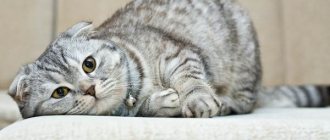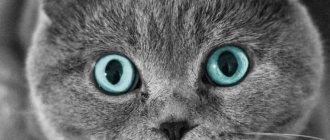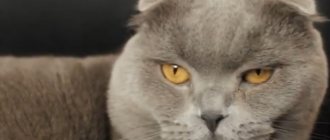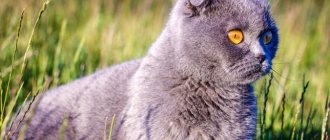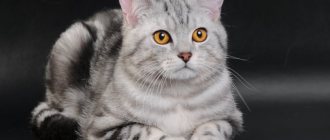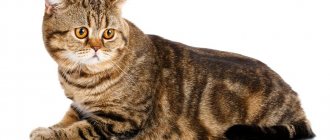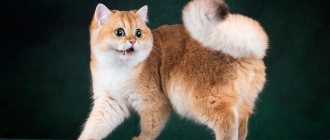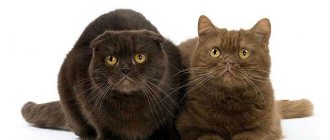10929Administration
At 3 months old, a Scottish Fold kitten is quite independent and adapts perfectly to a new place of residence. Therefore, it is at this age that it is recommended to buy a small pet and accustom it to a new home. The nutrition of such a kitten, as a rule, has already been established by the breeders and the new owners will not have any problems in selecting food or preparing a diet.
There will also be no problems in teaching your baby to use the toilet, his own place; At this age, the main character traits are clearly visible, thanks to which you can choose the one who will fully meet your expectations. Choosing a Briton with an easy-going character will always be a pleasure . Before choosing a three-month-old Scottish kitten, it is worth studying several sections of information:
- at what interval and what to feed him;
- when is it necessary to vaccinate and what kind of vaccinations are needed;
- what conditions are necessary for a comfortable location;
- how much does a Scottish kitten weigh at 3 months and what should it look like.
© shutterstock
Types of diets
For a kitten, you can choose one of the types of food:
- “Natural” , but this is not food from a person’s table. These are properly selected products that undergo a certain heat treatment. The benefit of such nutrition is that it is as close as possible to natural and natural for animals. It is possible to make your pet’s diet tasty and varied. Disadvantages: wasting time on daily food preparation, insufficient amounts of vitamins and minerals supplied with food. On a natural diet, the kitten will have to be given additional vitamin complexes.
- Industrial food . The best option for both the Scottish Fold and his owner. Dry industrial food contains all the useful substances necessary for the full and harmonious development of a pet. The disadvantage is that good, high-quality food, for example, holistic food, is expensive, but this is what is recommended to be given to the animal.
- Mixed nutrition. As a rule, the combination of industrial food and natural products is not recommended by veterinarians, although many owners often use such a diet. A high concentration of vitamins in food and their presence in natural products can provoke the development of hypervitaminosis in a kitten.
What to feed should be decided immediately when a little Scotsman appears in the house and you should always adhere to the chosen type of diet. Changing the menu from natural to industrial or vice versa has a negative impact on the health of the animal.
Distinctive features
This breed is distinguished by its striking manifestation of sexual dimorphism: males are larger and stockier than females, cats are more graceful and elegant.
- almost perfectly round head on a short neck;
- elegant body;
- well developed outstretched paws;
- long straight tail.
The main feature that distinguishes them from the British is their miniature ears, triangular in shape. Because of the crease, they seem to be bent down and pressed against the skull.
International associations allow all colors - from white to tortoiseshell, but there are exceptions: lavender, chocolate and colorpoint.
Power type
For Scottish Fold kittens, one of the following types of food intake is selected:
- Measured . During the day, the kitten receives food in small portions. The advantage of the regime is that the kitten is well-fed, does not overeat, and the likelihood of obesity and other health problems in the future is reduced. Disadvantage: difficulties for the owner. The feeding schedule is extremely inconvenient for people who are away from home for a long time and cannot regularly (hourly) feed the kitten.
- Continuous mode . There is always food in the bowl. The food is topped up every time the bowl is empty. Disadvantage: There is a risk of obesity. The kitten cannot control the amount of food it eats. The advantage for the owner is that he can be away from home for a long time without worrying about his pet’s diet.
For Scottish Folds, a measured meal schedule is optimal. Given the risks of obesity with a continuous feeding schedule, it is recommended to use it only when absolutely necessary.
How to choose a cat
Despite the fact that the Scottish Fold cat is a young breed, it is not difficult to buy one. Nurseries are actively working to popularize the breed.
When choosing a kitten, carefully read the documents, inspect it and talk to the breeder.
Remember that the Skotish Fold can be any color.
toilet trained and initially socialized.
You can read about how to determine the age of a kitten here:
For those planning to exhibit their pet, you should check the kitten's tail. There should be no knots or creases on it, it should move well.
The external difference and main advantage of Skotish folds are their ears, folded towards the forehead. Don't be alarmed if they are slightly raised.
It all depends on the speed of development of each branch of the breed: the ears can become crooked later, when the kitten’s head increases in size.
Features of natural nutrition
When choosing to feed your pet natural products, you should first find out what can be given to the kitten and what can be harmful to its health.
Authorized Products
Allowed in the diet of a Scottish baby:
- Beef – raw, pre-frozen.
- Chicken - only boiled, without skin, breast is preferable.
- Liver – boiled, given no more than once a week.
- Fish – low-fat varieties: hake, perch or carp. The fish should be boiled, cleaned of bones. It can be given no more than once a week.
- Fermented milk products with minimal fat content : cottage cheese, kefir, fermented baked milk and sour cream.
- Cereals cooked in milk or water : buckwheat, oatmeal and rice. Prepared without salt and sugar. Allowed for use no earlier than 5 months. Cereals are not independent food. They need to be mixed with meat, fish or vegetables.
- Vegetables are sources of carbohydrates necessary for a kitten’s growing, active body. Serve raw, grated, without salt, you can add a little vegetable oil, preferably olive. Recommended vegetables: carrots, cabbage, green beans.
- Fruits – sources of vitamins, but also allergens. You can give them to a kitten, but rarely and in limited quantities. Preference is given to unsweetened varieties of apples, chopped through a grater.
The main rule is the basis of the daily menu - meat.
Prohibited Products
It is strictly forbidden to feed a Scottish Fold kitten:
- homemade and purchased sweets, confectionery;
- fatty meat and fish;
- flavor dishes with salt, spices and sugar;
- pickles and marinades;
- baked, steamed or fried meat;
- smoked meats.
In addition, it is forbidden to give the animal food from the common table, no matter how the pet begs for a treat.
MisterCat warns: advantages and disadvantages
The breed has various advantages and disadvantages.
| pros | Minuses |
| Sweet beautiful face. | Greed. |
| Friendliness. | Indiscriminate eating. |
| High intelligence. | Prohibition on mixing with fold-eared and British cats. |
| Wide range of colors. | Selfishness. |
| Good health and long life. | Stubborn character. |
| Love for cleanliness. | Fear of moving. |
Industrial feed
When choosing feeding with ready-made food, you need to take into account a number of nuances:
- The production diet must be of high quality. Recommended categories are holistic, super premium and premium. It is necessary to choose food according to the age of the pet.
- Feeding should be carried out strictly according to the schedule, in order to avoid obesity and an excess of vitamin substances in the body of a growing baby.
- Maintain drinking regime. This is important with any type of food, but especially if the kitten eats dry kibble. The kitten should drink at least 150-200 ml of liquid per day.
- For the smallest kittens, it is recommended to choose canned food or jelly. From the age of 6 months, you can switch the animal to large, dry granules.
- It is allowed to feed the kitten dry granules and jelly and canned food, but not at the same meal, without mixing in the same bowl.
Recommended food for Scottish Fold kittens: Royal Canin, Hills, Advence, Matisse.
note
You should not focus solely on the baby’s appearance when meeting you; you must take into account the habits, character traits and sociability of a particular Scottish kitten at 3 months.
At this age, he should clearly know where the tray is, easily make contact, respond with purrs to various caresses and strokes, and also have a healthy appetite.
If the baby shows aggression, it is necessary to pay attention to the conditions of his detention in order to determine whether this is an innate character trait, or whether it is simply the presence of irritating factors, such as: too small an area for habitat, a large number of small kittens, insufficient care. If you carefully choose your new pet, he will delight you for many years or months and will become an excellent friend in a cozy home.
Diet by month
The easiest way is to choose industrial - dry and wet food for kittens. The product packaging indicates the age at which it is recommended to consume ready-made food. You need to create a natural diet yourself, taking into account the needs of a kitten at a certain age and the functioning of the digestive system.
1 month
The introduction of the first complementary foods begins. In addition to cat milk or a special formula for feeding a kitten, you can gradually introduce some products into the diet:
- boiled chicken, cut into small pieces;
- cereals cooked in milk diluted with water in equal proportions;
- boiled vegetables and fruits chopped through a grater: cabbage, carrots, apples;
- fermented milk products - the emphasis is on calcined curds.
The food is warmed to room temperature. There should be no food left in the bowl; it is removed after each feeding.
2 months
The active growth of the Scotsman and the appearance of teeth require an expansion of the diet:
- boiled meat - chicken or beef, without salt;
- low-fat fermented milk products;
- boiled cereals;
- raw vegetables;
- chicken egg yolk - boiled or raw, with its addition to meat or cereals.
The meat is cut into pieces, but not very small.
3 months
The kitten’s teeth are already formed, and therefore the meat is cut into fairly large cubes. Sample menu:
- boiled beef or chicken without skin;
- raw vegetables, grated through a medium grater;
- cereals;
- egg yolk;
- low-fat cottage cheese, fermented baked milk;
- fish of lean varieties, but only boneless fillet, pre-frozen or boiled (no more than once a week);
- offal.
Recommended offal: chicken hearts and necks, navels, boiled or frozen. They should be brought to room temperature before serving.
4 months
The diet is gradually and little by little expanding:
- raw, pre-frozen beef, boiled chicken;
- cereals cooked in water;
- 1-2 yolks per week – boiled or raw;
- raw vegetables, fruits;
- dairy products;
- sea fish of lean varieties.
Sea fish should be introduced into the diet gradually, starting with a small piece. This product can cause allergies, so it is important to carefully monitor your pet’s reaction. It is strictly forbidden to give raw fish; it must be boiled.
5 months
At this age, the kitten develops especially actively, so the menu is appropriate:
- raw and boiled meat;
- fermented milk products;
- vegetables and grains;
- lean, low-fat beef broths;
- greens, special sprouted herbs for cats.
If the pet is on a natural diet, starting from 5 months, it can be given special vitamin complexes.
Description of the breed
According to international standards, the Scottish Straight breed should have the following characteristics:
- The body should be of medium size, dense, fairly muscular. The toes of the paws should be pressed tightly against each other. When moving, you should feel elasticity in the joints. The tail is preferably long, but medium length is also acceptable.
- The head should be round in shape with rounded muzzle and cheeks. Cats may have slightly plump cheeks. The neck is short.
- The ears are small and erect. The tips of the ears are slightly pointed, however, they are wide at the base. In the inner part there are brushes that are quite lush and dense.
- The eyes should be wide open and round. The color of the eyes matches the color of the coat. The nose is quite wide and short.
- The coat is dense, plush, of medium length.
A significant disadvantage of the Scottish Straight cat may be the presence of:
- flat forehead;
- arched back;
- proximity of the knee joints;
- rigidity and immobility of the tail;
- creaking in the area of intervertebral joints.
The reason for disqualification may be the presence of:
- hook on the tail;
- shortness of the tail;
- pain when moving.
Appearance of a Scottish Straight cat
The appearance of the Scots with straight ears is special and clearly distinguishes this breed from other felines. Scottish straights can be of various colors, namely:
- Lilac is a rather rare shade of fur, which is reflected in the cost of the kitten.
- Black - adds spectacular appearance to the animal.
- Blue is a fairly popular type of cat.
- Marbled - this color gained increased popularity after the appearance of an advertisement for cat food in which this breed participated.
- Cream is a fairly rare color.
- White - requires a lot of time to care for a snow-white coat.
- Red and tortoiseshell.
The Scottish Straight cat's muzzle is round with pronounced full cheeks. The cheeks of an adult cat are especially full. The Scottish nose does not have any humps. The tail is proportional to the body of the animal. In movement, the pet is incredibly flexible and graceful.
Not a single photo can convey the beauty of the Scottish Straight. The graceful, slightly rounded shape of the body looks very harmonious, and the amazing eyes accurately repeat the shade of the coat. The pet's look is cute and bewitching.
Features and behavior
Each kitten, like a person, has its own character. From an early age one can distinguish a calm phlegmatic person from an energetic choleric person.
Representatives of the Scottish Straight cat will not lie in one place for a long time. They will happily go out to explore the world around them, will listen to any rustles and sniff unknown aromas. Playful kids happily play with other pets living in the family or hunt for their own tail.
Personality of the straight-eared Scottish cat
Most Scottish Straights have a calm, balanced character. Thanks to their stable psyche, cats get along well with other animals. Despite their devoted love for all family members, they try to choose one owner for whom they will become a faithful companion. Pets happily play with children, but they do not intend to obey them.
Little Scottish kittens are overly active - they devote all their free time from sleep to playing and running around the room, hunting for their own shadow. Animals of this breed are quite smart and understand their owner almost instantly. Given their devotion to their family, Scottish Straight cats have a hard time withstanding loneliness and long-term absence of their owner.
Cats are very sensitive to their owner's condition. During periods of sadness, the Scotsman will definitely try to cheer up his owner by purring and rubbing him on the cheek. Very often, representatives of the breed greet their owner at the door, rejoicing at his return as much as a dog.
An important factor is the rapid potty training of your Scottish cat. The Scottish Straight cat can become an ideal loyal and understanding friend for almost every person.
Diet at 6 months: menu for neutered cats
At six months of age, most kittens undergo a castration procedure. From this point on, the pet’s diet needs to be revised, excluding a number of products from it.
After castration, the likelihood of obesity increases, so due attention should be paid to the nutrition of the Scottish Fold.
Features of feeding castrated animals:
- The menu should include foods enriched with fiber and vitamins.
- Complete exclusion of any type of fish from the diet, since it contains phosphorus and magnesium. Regular entry of these elements into the body of a castrated animal increases the likelihood of urolithiasis.
- Be sure to eat porridge. To make cereals tastier, you can add some lean meat to them.
- By-products - in small quantities, no more than once a week.
- Greens and specially sprouted trauma for cats.
- Vegetables are served only raw. Allowed: carrots, cucumbers, cabbage.
- It is recommended to give your pet low-fat beef broths several times a day.
If the Scottish Fold is on a ready-made food, you need to choose only those that are intended for sterilized and neutered animals. The feed must be of appropriate quality. Preference is given to holistic, super and premium classes.
For other kittens that are not castrated or sterilized, the menu remains the same, only the number of meals per day is reduced.
Temperament
The Scots are moderately active, preferring sleep to aimless running around. This does not prevent them from being playful and active when necessary. They love various games with toys, and with proper training they quickly learn commands.
Dependent on human attention. They quickly become attached to the family. They don’t choose a “favorite” - they love every family member equally. They cannot stand being alone for long periods of time, so people without a family and with a job that requires constant absence should not get a pet.
This does not mean that the pet is annoyingly intrusive; on the contrary, their high level of intelligence helps them understand when they are in the way. They are not loud, their voice is quiet and pleasant.
The only thing that throws a Scottish cat out of balance is moving or a new place. In this case, the owner should be nearby and help him adapt correctly.
Sociable pets react calmly to small children and other pets.
1-2 weeks
On the 3-4th day, the umbilical cord already falls off, and on the 5th day, hearing is formed - Scottish cats begin to hear background noise and slowly distinguish individual sounds. In the first week of life, babies' ears open and their first undercoat appears. The kittens become stronger - they begin to crawl around their nook.
At 2 weeks, babies can already release their claws. At this age, they take their first steps - still uncertainly, stuttering and stumbling. They sleep a little less, the intervals of wakefulness increase.
On the 12th-14th day, the “Scots” have eyes, but their vision is still poor and they cannot focus their eyes. Visual function is formed by 15-17 days of life
Babies already hear well - they respond to the call of their mother’s cat, and are curious in response to interesting sounds. They try to explore the world outside their “nest”.
Two week old Scottish kittens:
Adult pet
Scottish Folds are considered a medium-sized breed, but they are larger than outbred domestic cats. The weight of an adult animal ranges from 3 to 7 kg, and larger individuals are also found. Cats are much larger than cats.
In a year, females reach the bulk of their body weight and in the future can gain insignificant weight. Males grow up to 2.5 years. At the same time, the pet grows up to 70% of its size per year, and gains the remaining 30% over the next years.
An adult Scotsman reaches a size of 55 cm excluding the tail. In this case, the length of the tail should be equal to the distance from the shoulder blades to the tailbone or more. The height of adult cats is about 30 cm. If the cat’s parameters are very different from normal, this may indicate problems with bones or joints. In this case, you should consult your veterinarian.
Necessary care
When becoming the happy owner of a 3-month-old Scottish Fold (low-eared) or Scottish Straight (straight-eared), a person must consider the following:
- Quality of licking. The kitten tries hard to get its fur in perfect order, but it does not always have the perseverance to do it efficiently. If the owner helps with cleaning and combing the fur, then you should still teach him to wash the baby’s “buttocks” himself - sometimes lubricate the area under the tail with fish oil or vegetable oil.
- Upbringing. Three-month-old Scots, having just gotten used to it, begin to rush around the house “as if stung,” “attack” the owner’s legs and utter war cries. This is normal behavior for a kitten, but you need to start correcting his behavior - accustom him to a scratching post, discourage him from climbing on the kitchen table and “dining” with indoor flowers. The animal is not beaten or punished - they only scold in a stern voice, show the correct behavior (take it to a scratching post, cat grass), and ignore it for a while.
- Bathing and brushing. Three months is the ideal age to accustom a kitten to grooming and bathing procedures. His psyche is very plastic - the baby will soon get used to these unusual actions. The owner acts calmly, does not shout, speaks kindly, and rewards his efforts with “yummy treats.” It is already very difficult to accustom an adult, wayward “Scot” to such procedures.
- Vaccination. As a rule, the initial stage of the first vaccination remains on the conscience of the breeder. Then the owner brings his lucky acquisition to the veterinarian for an initial examination - the doctor prescribes an anthelmintic. After 10-14 days, the baby will be vaccinated again and a veterinary passport will be issued (if there is no document).
- Fortification. The kitten is actively developing - it does not have enough microelements from food. Therefore, the owner offers the “Scot” vitamin supplements with calcium and taurine. What remedy a particular kitten needs is determined only by a veterinarian.
Source
What to do if your weight is not normal
If underweight or overweight does not exceed 200 grams, then there is no reason to worry; most likely, the pet simply overate a little or did not move much. But if there is a large deviation from the norm, you need to contact a veterinarian, who will determine the cause and, if necessary, prescribe a course of treatment.
If your weight is below normal
If your Scottish Fold cat's weight at any stage of its growth is significantly below normal, you need to take your pet to a veterinarian. If the animal does not have problems with the gastrointestinal tract, the specialist will prescribe vitamins and give recommendations on changing the diet.
If your weight is higher than normal
Excess weight in a cat often causes the development of serious diseases, so the owner needs to monitor the diet and try not to overfeed the pet. If your pet is already overweight, you should review its diet and gradually reduce the portion size.
You will also have to take care of physical activity - you need to play with the cat more often to burn extra calories.
What should you primarily feed your Scotsman?
Before answering the question of what to feed a Scottish kitten for 4 months, it is worth studying its needs for daily intake of proteins, fats and carbohydrates, as well as microelements.
In no case should you allow a monotonous diet, which will include exclusively meat or porridge of a certain type or fish in its pure form.
Indeed, in this case, the functioning of the digestive tract is disrupted and when switching to a more balanced diet, your baby may have problems digesting food.
